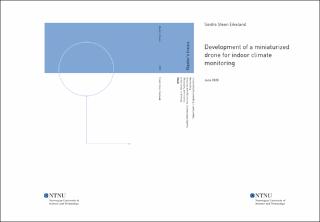| dc.contributor.advisor | Johansen, Tor Arne | |
| dc.contributor.advisor | Mathisen, Geir | |
| dc.contributor.author | Eikeland, Sindre Steen | |
| dc.date.accessioned | 2021-09-23T18:10:22Z | |
| dc.date.available | 2021-09-23T18:10:22Z | |
| dc.date.issued | 2020 | |
| dc.identifier | no.ntnu:inspera:56990118:34393859 | |
| dc.identifier.uri | https://hdl.handle.net/11250/2780943 | |
| dc.description.abstract | Denne masteroppgåva tar eit første steg inn i utviklinga av ei autonom drone for overvaking av innandørsklima.
Ei ramme vart designa og 3D-printa for å fungere som eit grunnlag for framtidig testing av sensorar for overvaking av innandørsklima, samt maskinvare for autonom styring av dronen.
I tillegg til ramma, vart det designa og 3D-printa eit sensorkammer med luftinntak for montering til ramma som ein ekstern modul. Det same vart gjort for LiDAR-fester. Det viste seg seinare at den innbilte metoden for å feste modulane til ramma ikkje fungerte, og ingen av modulane vart testa. Teoretiske estimat indikerte eit velfungerande sensorkammer, medan seinare analyse og diskusjon sådde tvil om dette, og presenterte heller eit alternativ.
Ei løysing før trådlaus lading vart utvikla og testa med suksess, med opp til 0.8 A ladestraum og eit potensiale på ca. 1.6 A. Løysinga kan brukast i eit autonomt oppsett, sjølv om det testa oppsettet manglar enkelte fordelaktige kvalitetar.
Dei utførde flytestane var dominert av ei driftande drone og, i byrjinga, mykje støy på gyroskopet. Sjølv om implementering av eit "notch filter" praktisk talt eliminerte støy på gyroskopet, fortsette driftinga. Ein gyroskop-akselerometer "dance theory" med ubalanserte motorar vart sett på som ei mogleg årsak til dette problemet.
Uheldigvis vart fleire komponentar i dronen seinare øydelagt, noko som gjorde at problemet med drifting aldri vart løyst. Av same årsak vart heller ikkje sensorkammeret testa.
Kort summert har denne masteroppgåva produsert ei konseptuell drone, med lågare vekt enn andre liknande eksempel, samtidig som den truleg er for stor til å kunne kallast ei "miniatyrisert drone". Plassering av miljøsensorar på dronen vart foreslått, der tilsvarande sensorar for nokre av dei ikkje var inkludert i eksisterande løysingar. Kombinert med grunnlag for trådlaus autonom lading finnast, så vidt forfattaren kjent, ingen liknande eksisterande dronar. | |
| dc.description.abstract | This thesis takes the first step into the development of an autonomous drone for indoor climate monitoring.
A frame was designed and 3D-printed, with the aim of providing a base for testing of indoor climate sensors and autonomous hardware in the future.
In addition to the frame, a sensor chamber with air intakes was printed for modular mounting to the frame. Also LiDAR mounts were designed and printed for modular mounting. Unfortunately, the mounting technique did not work as intended, and none of the external modules were tested. Theory implied a well working sensor chamber, while analysis and discussion gave some doubt and presented an alternative.
A wireless charging solution was developed and successfully tested, with a charging current up to 0.8 A, and later potential of ca. 1.6 A. The solution can be used as part of an autonomous solution, though the tested setup lacks some desirable features.
Flight tests conducted were dominated by a drifting drone and, initially, much gyro noise. With the implementation of a notch filter gyro noise was practically eliminated, but drifting persisted. A gyroscope-accelerometer "dance theory" and imbalanced motors seemed likely to be causing the drift.
Unfortunately, a fault in the drone resulted in damage to several components, and so the drifting was never resolved. The sensor chamber was, for the same reason, not tested either.
In short, this thesis has produced a conceptual drone lighter than discovered existing solutions. At the same time, the current prototype is likely too large for it to be called a miniaturized drone. Allocation of environmental sensors has also been suggested, some of which equivalents are not found in the existing solutions either. Combined with a base for wireless autonomous charging there are, to the best of knowledge, no existing drones similar to this. | |
| dc.language | | |
| dc.publisher | NTNU | |
| dc.title | Development of a miniaturized drone for indoor climate monitoring | |
| dc.type | Master thesis | |
